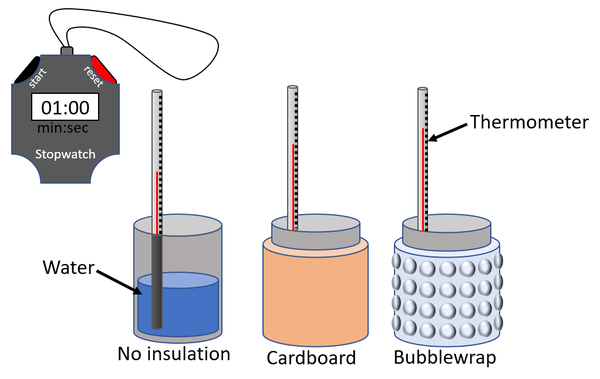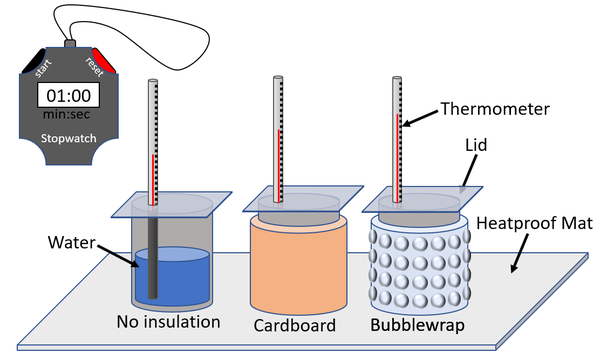Difference between revisions of "GCSE Physics Required Practical: Investigating Thermal Insulators"
(Created page with "==Key Stage 4== ===Meaning=== Investigate the effectiveness of different thermal insulators on reducing an energy transfer by heat...") |
(→Improving Precision) |
||
| (8 intermediate revisions by the same user not shown) | |||
| Line 1: | Line 1: | ||
==Key Stage 4== | ==Key Stage 4== | ||
| + | {{#ev:youtube|https://www.youtube.com/watch?v=MUy1o4ogCvw}} | ||
===Meaning=== | ===Meaning=== | ||
Investigate the effectiveness of different [[Thermal Insulator|thermal insulators]] on reducing an [[Energy Transfer|energy transfer]] by [[heating]]. | Investigate the effectiveness of different [[Thermal Insulator|thermal insulators]] on reducing an [[Energy Transfer|energy transfer]] by [[heating]]. | ||
| − | ===Variables=== | + | ===Experiment=== |
| + | ====Variables==== | ||
: [[Independent Variable]]: [[Thermal Insulator|Insulating material]]. | : [[Independent Variable]]: [[Thermal Insulator|Insulating material]]. | ||
: [[Dependent Variable]]: The [[temperature]] decrease of [[water]] after a given [[time]]. | : [[Dependent Variable]]: The [[temperature]] decrease of [[water]] after a given [[time]]. | ||
: [[Control Variable]]s: The [[Volume (Space)|volume]] of [[water]] used. The initial [[temperature]] of the [[water]]. The [[time]] taken between [[measurement]]s. Thickness of the [[Thermal Insulator|insulating material]]. | : [[Control Variable]]s: The [[Volume (Space)|volume]] of [[water]] used. The initial [[temperature]] of the [[water]]. The [[time]] taken between [[measurement]]s. Thickness of the [[Thermal Insulator|insulating material]]. | ||
| − | ===Method=== | + | ====Method==== |
| − | #Fill a can with hot [[water]] | + | {| class="wikitable" |
| − | #Place a [[thermometer]] in the [[water]] and wait until the [[temperature]] reaches | + | |- |
| − | #Begin a [[stopwatch]] when the [[temperature]] is | + | |[[File:RequiredPracticalThermalInsulation1.png|center|600px]] |
| + | |- | ||
| + | | style="height:20px; width:200px; text-align:center;" |A [[diagram]] of the [[apparatus]] used in an [[experiment]] to compare the effectiveness of different [[Thermal Insulator|thermal insulators]]. | ||
| + | |} | ||
| + | |||
| + | #[[Measure]] 100ml of hot [[water]] (around 50°C) using a [[Measuring Cylinder|measuring cylinder]]. | ||
| + | #Fill a can with hot [[water]] | ||
| + | #Place a [[thermometer]] in the [[water]] and wait until the [[temperature]] reaches 40°C. | ||
| + | #Begin a [[stopwatch]] when the [[temperature]] is 40°C then [[Reading|read]] the [[temperature]] every 30 seconds for 5 minutes. | ||
#Repeat steps 1-3 with a can covered each type of [[Thermal Insulator|insulating material]]. | #Repeat steps 1-3 with a can covered each type of [[Thermal Insulator|insulating material]]. | ||
| + | #Plot a [[graph]] with [[temperature]] on the [[y-axis]] and [[time]] on the [[x-axis]] plotting the [[results]] for each [[Thermal Insulator|insulating material]] on the same [[graph]]. | ||
| − | ===Improving [[Accuracy]]=== | + | ====Improving [[Accuracy]]==== |
: Place the cans on a [[Heatproof Mat|heatproof mat]] to reduce the [[Thermal Energy Store|thermal energy]] lost to the table surface by [[Thermal Conduction|conduction]]. | : Place the cans on a [[Heatproof Mat|heatproof mat]] to reduce the [[Thermal Energy Store|thermal energy]] lost to the table surface by [[Thermal Conduction|conduction]]. | ||
: Place a lid over the cans to reduce the [[Thermal Energy Store|thermal energy]] lost to the [[air]] by [[evaporation]]. | : Place a lid over the cans to reduce the [[Thermal Energy Store|thermal energy]] lost to the [[air]] by [[evaporation]]. | ||
: Complete the experiments with different [[Thermal Insulator|insulators]] simultaneously so that a change in the [[temperature]] of the [[laboratory]] does not affect the [[results]]. | : Complete the experiments with different [[Thermal Insulator|insulators]] simultaneously so that a change in the [[temperature]] of the [[laboratory]] does not affect the [[results]]. | ||
| − | = | + | : Place the [[Measuring Cylinder|measuring cylinder]] on a flat, level surface and read it from eye level to get an [[accurate]] reading of the [[Volume (Space)|volume]] of [[water]]. |
| − | : | + | |
| − | : | + | {| class="wikitable" |
| + | |- | ||
| + | |[[File:RequiredPracticalThermalInsulation2.png|center|600px]] | ||
| + | |- | ||
| + | | style="height:20px; width:200px; text-align:center;" |A [[diagram]] including [[apparatus]] used improve the [[accuracy]] of an [[experiment]] to compare the effectiveness of different [[Thermal Insulator|thermal insulators]]. | ||
| + | |} | ||
| + | |||
| + | ====Improving [[Precision]]==== | ||
| + | : Ensure the same amount of water ([[Control Variable]]) is used in each container to reduce the [[Random Error|random error]] in repeat readings. | ||
Latest revision as of 08:12, 17 October 2019
Contents
Key Stage 4
Meaning
Investigate the effectiveness of different thermal insulators on reducing an energy transfer by heating.
Experiment
Variables
- Independent Variable: Insulating material.
- Dependent Variable: The temperature decrease of water after a given time.
- Control Variables: The volume of water used. The initial temperature of the water. The time taken between measurements. Thickness of the insulating material.
Method
| A diagram of the apparatus used in an experiment to compare the effectiveness of different thermal insulators. |
- Measure 100ml of hot water (around 50°C) using a measuring cylinder.
- Fill a can with hot water
- Place a thermometer in the water and wait until the temperature reaches 40°C.
- Begin a stopwatch when the temperature is 40°C then read the temperature every 30 seconds for 5 minutes.
- Repeat steps 1-3 with a can covered each type of insulating material.
- Plot a graph with temperature on the y-axis and time on the x-axis plotting the results for each insulating material on the same graph.
Improving Accuracy
- Place the cans on a heatproof mat to reduce the thermal energy lost to the table surface by conduction.
- Place a lid over the cans to reduce the thermal energy lost to the air by evaporation.
- Complete the experiments with different insulators simultaneously so that a change in the temperature of the laboratory does not affect the results.
- Place the measuring cylinder on a flat, level surface and read it from eye level to get an accurate reading of the volume of water.
| A diagram including apparatus used improve the accuracy of an experiment to compare the effectiveness of different thermal insulators. |
Improving Precision
- Ensure the same amount of water (Control Variable) is used in each container to reduce the random error in repeat readings.

